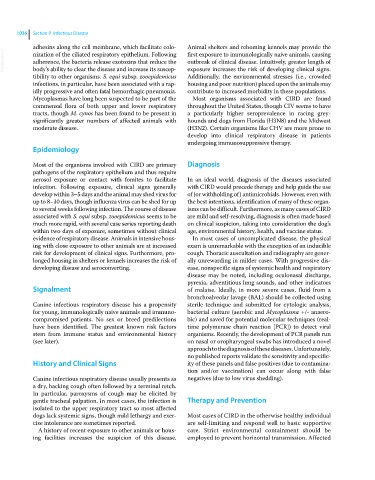Page 1098 - Clinical Small Animal Internal Medicine
P. 1098
1036 Section 9 Infectious Disease
adhesins along the cell membrane, which facilitate colo- Animal shelters and rehoming kennels may provide the
VetBooks.ir nization of the ciliated respiratory epithelium. Following first exposure to immunologically naive animals, causing
outbreak of clinical disease. Intuitively, greater length of
adherence, the bacteria release exotoxins that reduce the
body’s ability to clear the disease and increase its suscep-
Additionally, the environmental stresses (i.e., crowded
tibility to other organisms. S. equi subsp. zooepidemicus exposure increases the risk of developing clinical signs.
infections, in particular, have been associated with a rap- housing and poor nutrition) placed upon the animals may
idly progressive and often fatal hemorrhagic pneumonia. contribute to increased morbidity in these populations.
Mycoplasmas have long been suspected to be part of the Most organisms associated with CIRD are found
commensal flora of both upper and lower respiratory throughout the United States, though CIV seems to have
tracts, though M. cynos has been found to be present in a particularly higher seroprevalence in racing grey-
significantly greater numbers of affected animals with hounds and dogs from Florida (H3N8) and the Midwest
moderate disease. (H3N2). Certain organisms like CHV are more prone to
develop into clinical respiratory disease in patients
undergoing immunosuppressive therapy.
Epidemiology
Most of the organisms involved with CIRD are primary Diagnosis
pathogens of the respiratory epithelium and thus require
aerosol exposure or contact with fomites to facilitate In an ideal world, diagnosis of the diseases associated
infection. Following exposure, clinical signs generally with CIRD would precede therapy and help guide the use
develop within 3–5 days and the animal may shed virus for of (or withholding of) antimicrobials. However, even with
up to 8–10 days, though influenza virus can be shed for up the best intentions, identification of many of these organ-
to several weeks following infection. The course of disease isms can be difficult. Furthermore, as many cases of CIRD
associated with S. equi subsp. zooepidemicus seems to be are mild and self‐resolving, diagnosis is often made based
much more rapid, with several case series reporting death on clinical suspicion, taking into consideration the dog’s
within two days of exposure, sometimes without clinical age, environmental history, health, and vaccine status.
evidence of respiratory disease. Animals in intensive hous- In most cases of uncomplicated disease, the physical
ing with close exposure to other animals are at increased exam is unremarkable with the exception of an inducible
risk for development of clinical signs. Furthermore, pro- cough. Thoracic auscultation and radiography are gener-
longed housing in shelters or kennels increases the risk of ally unrewarding in milder cases. With progressive dis-
developing disease and seroconverting. ease, nonspecific signs of systemic health and respiratory
disease may be noted, including oculonasal discharge,
pyrexia, adventitious lung sounds, and other indicators
Signalment of malaise. Ideally, in more severe cases, fluid from a
bronchoalveolar lavage (BAL) should be collected using
Canine infectious respiratory disease has a propensity sterile technique and submitted for cytologic analysis,
for young, immunologically naive animals and immuno- bacterial culture (aerobic and Mycoplasma +/‐ anaero-
compromised patients. No sex or breed predilections bic) and saved for potential molecular techniques (real‐
have been identified. The greatest known risk factors time polymerase chain reaction [PCR]) to detect viral
stem from immune status and environmental history organisms. Recently, the development of PCR panels run
(see later). on nasal or oropharyngeal swabs has introduced a novel
approach to the diagnosis of these diseases. Unfortunately,
no published reports validate the sensitivity and specific-
History and Clinical Signs ity of these panels and false positives (due to contamina-
tion and/or vaccination) can occur along with false
Canine infectious respiratory disease usually presents as negatives (due to low virus shedding).
a dry, hacking cough often followed by a terminal retch.
In particular, paroxysms of cough may be elicited by
gentle tracheal palpation. In most cases, the infection is Therapy and Prevention
isolated to the upper respiratory tract so most affected
dogs lack systemic signs, though mild lethargy and exer- Most cases of CIRD in the otherwise healthy individual
cise intolerance are sometimes reported. are self‐limiting and respond well to basic supportive
A history of recent exposure to other animals or hous- care. Strict environmental containment should be
ing facilities increases the suspicion of this disease. employed to prevent horizontal transmission. Affected

